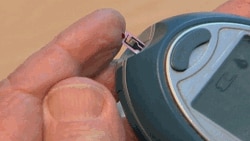Scientists have identified a unique genetic mutation in about 10 percent of people with type 2 diabetes studied in the United States and Europe. The discovery could help some people learn if they are at risk of developing diabetes so they can seek early treatment and possibly avoid getting the disease altogether.
More than 200 million people worldwide suffer from type 2 diabetes, a potentially fatal disorder. The World Health Organization expects diabetes-related deaths to double by 2030. Diabetes strikes people in rich and poor countries alike. World Health Organization statistics show that more than 80% of diabetes deaths occur in low- and middle-income countries. Age and obesity are two risk factors for type 2 diabetes. Another is family history.
"Diabetes is a very important disease that is increasing in every country in the world," says Dr. Ira Goldfine, who has been studying the DNA of people with and without diabetes. "And we need to know what causes it. And we have to get better treatments for it."
With type 2 diabetes, the body cannot turn blood sugar into energy. When sugar builds up in the blood, it can lead to serious complications including death. That's why people afflicted with the disease need to monitor their blood sugar.
"I have to test my blood virtually every day and make sure that my blood sugar is in a relatively normal range," says Dr. Arthur Lyons was diagnosed with type 2 diabetes three years ago.
It was while studying DNA that Goldfine and his colleagues isolated the genetic mutation.
"We found a protein that’s important, and we found that there are defects of this protein in diabetics," he says.
The gene that makes this protein is called HMGA-1. The protein is important because it is an insulin receptor, which enables insulin to attach to liver cells and converts blood sugar to energy.
"If you don’t have the HMGA-1 gene, then you don’t make the insulin receptor, and if you don’t make the insulin receptor, insulin doesn’t work very effectively," says Goldfine.
Goldfine is one of the co-authors of the study that found the HMGA-1 mutation in some Italian diabetics. The researchers then repeated the finding in American and French patients. All patients were Caucasian. They found that about 10 percent of type 2 diabetics in the United States and Europe, again all Caucasian, have defects in this gene”
"We have a screening test now to identify these people and people who are related to them so we can start treatment and intervention early," says Goldfine.
Early intervention for people with the HMGA-1 mutation including lifestyle changes: getting enough exercise, keeping weight in the normal range and monitoring blood sugar could prevent some people from developing type 2 diabetes. The researchers also say understanding the genetic component of this disease could help doctors provide better treatments to patients with type 2 diabetes, or even one day correct the genetic defect and prevent the disease that way.









